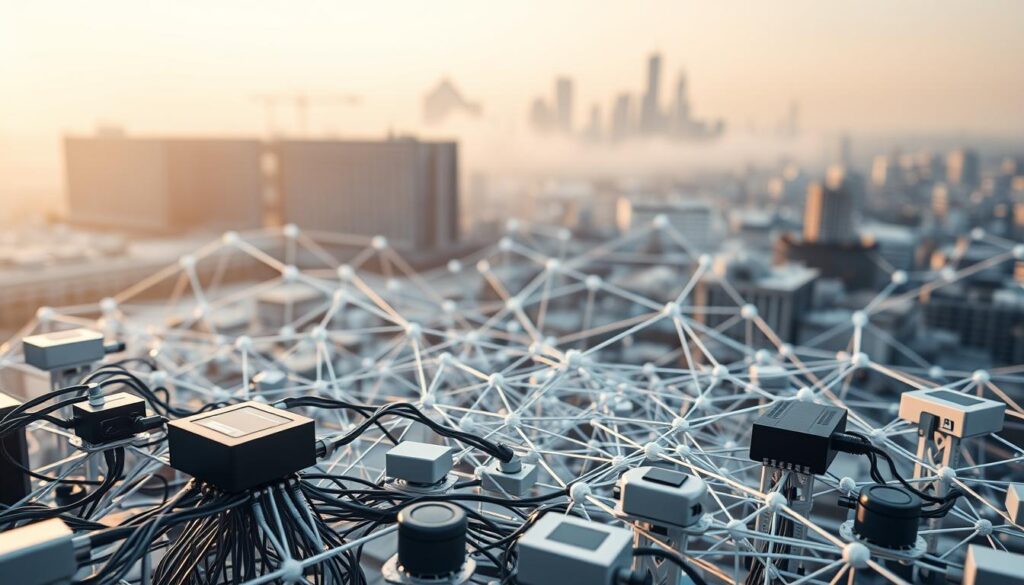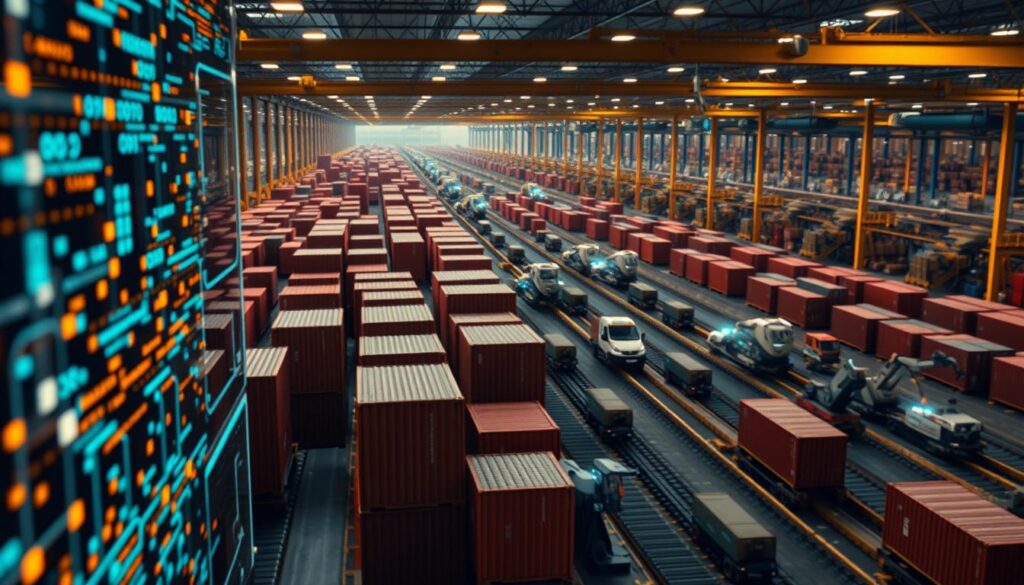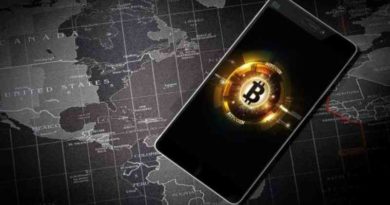Blockchain Meets IoT: Unlocking a Decentralized and Secure Future
About 75% of companies are using or planning to use blockchain and IoT. This shows a big move towards a safer and more open future. Blockchain and IoT together change how we handle data, keep it safe, and use networks. With more IoT devices, we need better ways to talk between them, and blockchain is key.
Blockchain and IoT together bring many benefits. They make data safer and more reliable. They also help with supply chains and smart cities. Companies can grow and innovate with these technologies. They will change many fields, like making things, health care, and moving stuff around.
Blockchain is getting more important in IoT. It makes data and device talks safe and open. As IoT grows, so does the need for safe talks. Blockchain will be a big help in this area. It will make IoT apps better and change many industries.
Key Takeaways
- The convergence of blockchain and IoT is revolutionizing the way we approach data integrity, security, and decentralized networks.
- Blockchain technology is poised to play a critical role in securing and optimizing IoT applications.
- The integration of blockchain and IoT has the ability to unlock numerous benefits, including enhanced security, data integrity, improved supply chain management, and smart city infrastructure.
- Companies are already implementing or planning to implement blockchain and IoT solutions, indicating a significant shift towards a decentralized and secure future.
- The use of blockchain technology in IoT applications is becoming increasingly important, as it provides a secure and decentralized way to manage data and communicate between devices.
- Blockchain and IoT will likely have a significant impact on various industries, including manufacturing, healthcare, and transportation.
Understanding the Convergence of Blockchain and IoT
Blockchain and IoT devices are coming together fast. This mix is set to change many industries. It’s all about keeping data safe and making systems more efficient.
Think of supply chain management and smart cities. Blockchain helps track goods and keeps them real. It also makes energy and transport systems better and safer.
Defining Blockchain Technology in IoT Context
In IoT, blockchain is a network that keeps data safe. It’s key for IoT devices that share sensitive info. This info needs to stay private.
The Evolution of IoT Infrastructure
IoT has grown a lot, with better devices and networks. Now, we can build complex systems like smart cities and automated factories.
Why Blockchain Matters for IoT Applications
Blockchain is vital for IoT because it keeps data safe and decentralized. This is super important for areas like healthcare and finance.

- Enhanced security: Blockchain provides a secure way to transmit and store data, reducing the risk of unauthorized access.
- Decentralized network: Blockchain enables the creation of decentralized networks, which can be more resilient and flexible than traditional centralized networks.
- Increased efficiency: Blockchain can automate many processes, increasing efficiency and reducing costs.
| Application | Benefits of Blockchain |
|---|---|
| Supply Chain Management | Increased security, transparency, and efficiency |
| Smart Cities | Improved energy management, public transportation, and security |
The Current State of IoT Security Challenges
The rise in IoT devices has brought up many security worries. This makes iot solutions very important today. With more IoT devices around, the danger of cyber attacks and data leaks grows too.
IoT devices are often weak spots for hackers. They can sneak into these devices and steal important data. This shows we need better security, like blockchain development, to keep IoT safe from cyber threats.
IoT devices face several big security issues. These include:
- Lack of standardization in IoT protocols
- Insufficient security protocols
- Vulnerability to malware and ransomware attacks
To tackle these problems, we need a strong plan. This includes creating secure iot solutions and using blockchain development. This will help keep IoT devices and networks safe and secure.

How Blockchain Transforms IoT Architecture
Blockchain technology is changing the Internet of Things (IoT) architecture. It offers a secure, decentralized, and efficient way for data exchange and device communication. This integration makes a trusted and transparent network where devices can talk to each other without needing a central authority.
Decentralized Network Benefits
The decentralized nature of blockchain technology makes IoT networks more resilient and adaptable. With a decentralized network, devices can keep working even if one node fails. This is key for IoT, where devices are often in remote or hard-to-reach places.

Smart Contract Integration
Smart contracts help automate decision-making and ensure devices act as planned. By adding smart contracts to IoT devices, organizations can make their networks more autonomous and efficient. Devices can then make decisions based on set rules and conditions.
Blockchain and smart contracts also open up new business models and revenue streams in IoT. For instance, organizations can create token-based systems. Devices can earn tokens for doing specific tasks or providing certain services.
Essential Components of Blockchain-IoT Integration
The mix of blockchain tech with the internet of things (IoT) is growing fast. It could change how we use and protect IoT devices. With blockchain security, IoT devices become safer, clearer, and more efficient.
Key parts of blockchain-IoT integration include:
- Decentralized networks, which enable secure and transparent communication between devices
- Smart contracts, which automate decision-making and execution of actions
- Data encryption, which protects sensitive information from unauthorized access
These parts together make a strong and safe IoT system. Devices can talk to each other and their surroundings in a trusted way. Blockchain security in IoT helps stop data leaks, keeps data safe, and offers a secure way to communicate.

Using blockchain tech and the internet of things makes our world more secure, efficient, and open. Devices and systems can work together in a trusted and reliable way.
| Component | Description |
|---|---|
| Decentralized Networks | Enable secure and transparent communication between devices |
| Smart Contracts | Automate decision-making and execution of actions |
| Data Encryption | Protect sensitive information from unauthorized access |
Security Enhancements Through Blockchain Technology
Blockchain technology can greatly improve IoT device and network security. It makes IoT solutions more secure and transparent. This is mainly done through better authentication and access control.
Authentication and access control are key for IoT security. They make sure only approved devices and users can join the network. Blockchain uses cryptography and smart contracts for this. It helps build secure, decentralized networks where devices and users can trust each other.
Key Security Enhancements
- Authentication and access control: Blockchain technology enables secure authentication and access control through the use of cryptographic techniques and smart contracts.
- Data encryption methods: Blockchain technology utilizes advanced data encryption methods to protect data from unauthorized access.
- Threat detection and prevention: Blockchain technology enables real-time threat detection and prevention, allowing for swift action to be taken in the event of a security breach.
Using blockchain in IoT security can make networks more secure and decentralized. This technology could change how we handle security. It could lead to networks that are safe and reliable for many uses.

Data Integrity in IoT Networks
Data integrity is key in IoT networks, where lots of data is sent and received. Blockchain development helps by making data storage and sharing safe and open.
Iot connectivity is also vital. Blockchain makes it better by letting IoT devices talk securely to each other. This lowers the chance of data theft and cyber attacks.

- It makes data safer and more reliable.
- It creates a network that’s not controlled by one person.
- It improves how IoT devices talk to each other.
With blockchain development and iot connectivity, IoT networks get better. They become more secure, efficient, and reliable. This opens up many new uses and applications.
Smart Cities and Blockchain-IoT Applications
Blockchain and IoT together can change smart cities. They make managing urban areas secure, efficient, and open. This tech ensures IoT data is safe and reliable.
Here are some ways blockchain and IoT help smart cities:
- Urban infrastructure management: Blockchain helps manage roads, bridges, and buildings.
- Public transportation systems: It makes public transport better by cutting down on traffic and boosting safety.
- Energy grid optimization: Blockchain improves how energy is shared, cutting down on waste and boosting efficiency.
Urban Infrastructure Management
Blockchain creates a network for managing city infrastructure. It allows for real-time monitoring and upkeep.
Public Transportation Systems
Blockchain makes public transport better. It reduces traffic and makes travel safer by sharing data securely.
Energy Grid Optimization
Blockchain helps manage energy. It makes sharing energy between producers and consumers safe and open.

Supply Chain Revolution with Blockchain and IoT
Blockchain and IoT are changing the game in supply chain management. They make supply chains more secure and trustworthy. This ensures products are real and can’t be tampered with.
Using blockchain in supply chains brings many benefits. Here are a few:
- Enhanced blockchain security to prevent counterfeiting and tampering
- Improved data integrity through the use of iot devices to track and monitor products
- Increased transparency and accountability throughout the supply chain
Big names like Maersk and Walmart are already on board. They’re using blockchain to cut costs, boost efficiency, and serve their customers better.

Blockchain and iot devices are set to become even more popular in supply chain management. Companies want to make their supply chains more secure, reliable, and efficient. As the tech advances, we’ll see even more creative uses in the future.
| Company | Blockchain Application |
|---|---|
| Maersk | Supply Chain Management |
| Walmart | Food Safety |
Implementation Challenges and Solutions
Integrating blockchain with IoT solutions comes with challenges. Scalability is a big issue as more devices and data are added. This can cause network slowdowns and higher energy use.
To solve these problems, developers use sharding. This breaks the network into smaller parts for faster processing. Off-chain transactions also help by handling data outside the main blockchain, reducing congestion.
Scalability Issues
Another hurdle is linking blockchain with old systems. This can be tough due to compatibility problems. To fix this, developers use application programming interfaces (APIs). APIs help connect blockchain systems with existing ones, making it easier to build complex IoT solutions.
Energy Consumption Concerns
The energy use of blockchain networks is a big worry. To lessen this, developers turn to proof-of-stake (PoS). PoS uses less energy to verify transactions. This makes blockchain applications more eco-friendly for IoT.
Integration with Legacy Systems
In summary, combining blockchain with IoT needs careful thought on scalability, energy use, and old system integration. By employing sharding, off-chain transactions, and energy-saving algorithms, developers can build efficient, safe, and green IoT solutions. These solutions use blockchain’s power effectively.
Best Practices for Blockchain-IoT Development
When working on blockchain development for IoT, there are key practices to follow. First, make sure the blockchain network is both secure and scalable. This means using strong security like encryption and access controls. Also, pick a consensus algorithm that can grow with your project.
Another important thing is iot connectivity. IoT devices need to talk to the blockchain safely and well. Use standard protocols like MQTT or CoAP. Also, have a system to manage and secure your devices.
Here are some top tips for blockchain-IoT development:
- Do deep security audits and tests to find weak spots
- Set up strong access controls and ways to prove who you are
- Use common communication protocols for iot connectivity
- Make sure your blockchain network can handle growth and stay fast
By sticking to these guidelines, developers can build blockchain-IoT apps that are safe, grow well, and work efficiently.
Real-World Success Stories and Case Studies
Blockchain and IoT have merged to create new solutions in many fields. Companies use blockchain to make IoT networks secure, decentralized, and efficient. This section will look at some success stories and case studies that show how blockchain and IoT work together.
In the manufacturing world, blockchain and IoT help track inventory and improve supply chains. For instance, Siemens uses a blockchain-based IoT system to better manage its supply chain. In healthcare, blockchain and IoT keep patient data safe and track medical devices.
Manufacturing Industry Applications
- Inventory tracking and management
- Supply chain optimization
- Predictive maintenance
Healthcare Solutions
- Patient data security
- Medical device tracking
- Health metric monitoring
These examples show how blockchain and IoT can change industries. By using blockchain, companies can make IoT networks secure and efficient. This leads to innovation and growth.
| Industry | Application | Benefits |
|---|---|---|
| Manufacturing | Inventory tracking | Improved efficiency, reduced costs |
| Healthcare | Patient data security | Enhanced security, improved patient outcomes |
| Agriculture | Crop monitoring | Increased yields, reduced waste |
Cost Considerations and ROI Analysis
When we add blockchain tech to iot devices for better security, we must think about the costs. This tech can change the price of iot devices and networks a lot.
One important thing to look at is the cost of setting up and keeping a blockchain system running. This includes the price of hardware, software, and the people needed to manage it. But, blockchain’s benefits like better blockchain security and data safety can save money in the long run. This can make the investment worthwhile.
Some good things about blockchain in iot devices are:
- It makes data safer and more reliable.
- It makes processes more efficient and automated.
- It brings more transparency and accountability.
Experts say using blockchain in iot devices can save a lot of money and give a good return on investment. As blockchain tech gets better, we’ll see even more cool uses in iot devices and networks.
Regulatory Compliance and Standards
As blockchain applications and iot solutions grow, following rules becomes key. Governments and groups worldwide set guidelines. These ensure these technologies are used safely and efficiently.
Creating blockchain applications and iot solutions must follow many rules. This includes laws about protecting data and privacy. Companies need to know these rules to stay out of trouble.
Global IoT Regulations
IoT rules differ by country but often focus on safety and data protection. For instance, the European Union’s GDPR has strict rules for handling data.
Blockchain Compliance Requirements
Blockchain applications must meet rules against money laundering and knowing who your customers are. These rules help stop bad activities and keep blockchain transactions safe.
Industry-Specific Standards
Standards for different fields, like healthcare and finance, are being made. These standards will help iot solutions and blockchain applications work well in these areas.
In summary, following rules is vital for blockchain applications and iot solutions to grow. By following these guidelines, companies can make sure these technologies are used safely and efficiently. This leads to new ideas and progress in many fields.
| Regulation | Description |
|---|---|
| GDPR | General Data Protection Regulation |
| AML | Anti-Money Laundering |
| KYC | Know-Your-Customer |
Future Trends in Blockchain and IoT Integration
The future of blockchain development and iot connectivity looks bright. More people will want secure and decentralized networks. As IoT devices increase, so will the need for strong security. This will push blockchain technology to the forefront.
Here are some trends that will shape the future of blockchain and IoT:
- Blockchain-based security will protect IoT devices from cyber threats.
- New, efficient blockchain platforms will support big IoT projects.
- There will be more focus on making different blockchain and IoT systems work together.
As blockchain development grows, we’ll see new uses in IoT. This includes better iot connectivity and smart city systems. Blockchain’s ability to improve security and efficiency makes it key for IoT’s future.
Preparing Your Business for Blockchain-IoT Adoption
When thinking about using blockchain and iot, getting ready is key. Blockchain technology boosts security and keeps data safe. It also helps create decentralized networks, which is great for iot.
First, businesses need to figure out where blockchain and iot can help the most. They should look at their current setup, find new uses, and plan what they need to get started.
Assessment and Planning
- Identify areas for blockchain and iot integration
- Evaluate current infrastructure and resources
- Determine possible uses and benefits
Team Training Requirements
After planning, it’s time to train the team. They need to learn about blockchain and iot basics. They also need to know how to use and manage these technologies.
Implementation Roadmap
Having a solid plan is vital for using blockchain and iot well. It’s important to set goals, plan timelines, and make sure you have the right resources. Also, having a way to check progress is essential for a smooth transition.
| Phase | Tasks | Timeline |
|---|---|---|
| Assessment and Planning | Identify areas for integration, evaluate infrastructure, determine use cases | 2-4 weeks |
| Team Training | Provide blockchain and iot training, educate employees on implementation and management | 4-6 weeks |
| Implementation | Integrate blockchain and iot, establish monitoring and evaluation process | 8-12 weeks |
Conclusion
The mix of blockchain technology and the Internet of Things (IoT) is changing the game. It’s making industries better and changing how we use technology. Blockchain’s security, decentralization, and openness make IoT devices safer and more reliable.
Smart cities and better supply chains are just the start. Blockchain and IoT together mean security and efficiency can go together. As more businesses and governments use this tech, we’ll see new and exciting things.
But, there are hurdles like making it bigger, using less energy, and working with old systems. The industry is working hard to solve these problems. This way, a safe and decentralized IoT future is within reach.
Looking forward, the future of blockchain and IoT is full of possibilities. These technologies together will bring us smart, safe, and open solutions. They will change industries and make life better for everyone.




